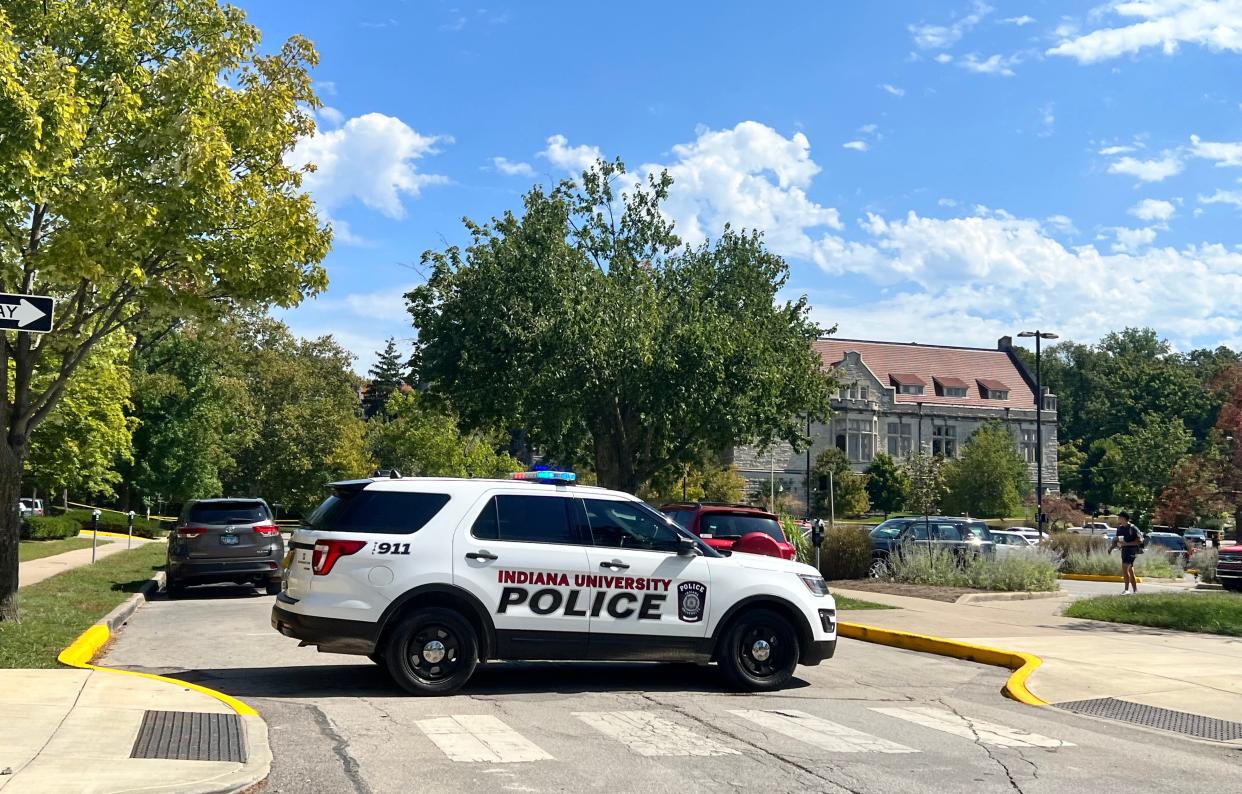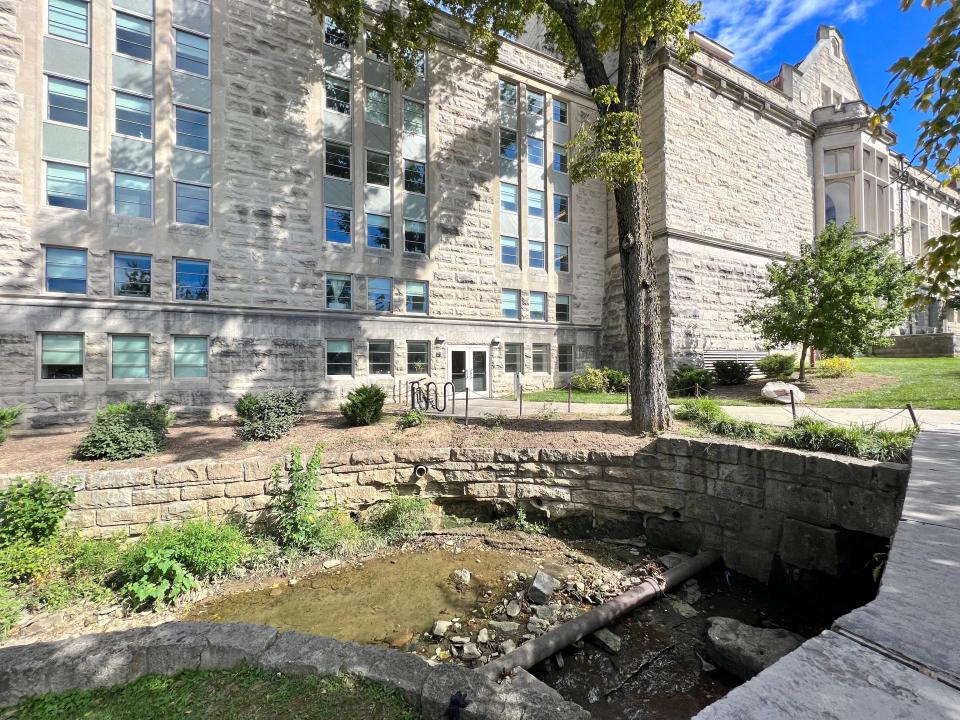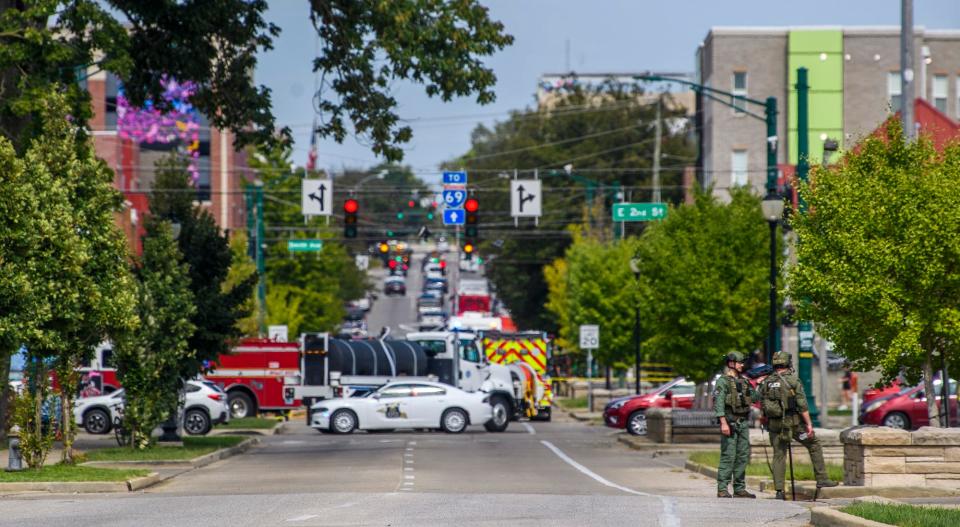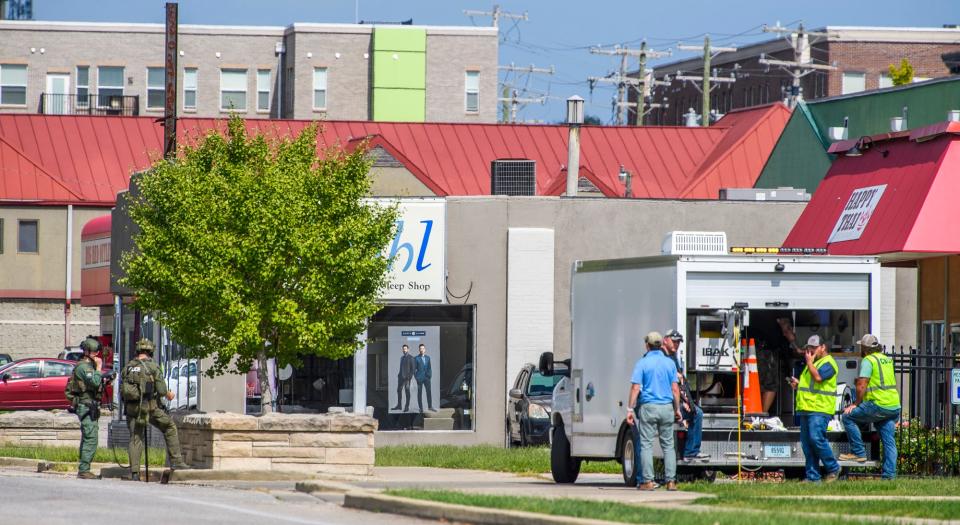'This is my first lockdown. In college.' A day in the life of the school-lockdown generation

The regular school day ended, as so many regular schooldays do in America, with a text alert.
“An armed subject has been reported entering the storm drain off campus,” said the bulletin from Indiana University at 12:29 p.m. Then the next: “Occupants of Franklin Hall should shelter in place.”
It was Tuesday and I was teaching a crime reporting exercise. Proximity, I had just told my news editing class, was one of the lesser news values. It’s important, but you usually don’t emphasize it. Impact, Conflict, those are the biggies.
A student broke the news: “We’re on lockdown.”
We looked at one another. Someone received a texted photo of a man with a rifle. Shooter? Police sniper? I projected it on the screen, where it attained a life-size dimension.
“Do you mind if I lock the door?” a girl asked, so politely. But the door wouldn’t lock without a key, so I led all of them upstairs to my office.
In Franklin Hall – home to the Media School, with its reporting labs and broadcast studio – classes drained. Students and professors wedged themselves into offices only to realize each had a floor-to-ceiling window.
As the last of my students filed into my office, I locked eyes with some stragglers in the hall, who looked puzzled about where to go. I needed to close the door, so I did.
We tilted a desk onto its end and stacked it vertically against the door. We pressed our faces to the window that faced outside, where police were stringing yellow tape. The idyllic little campus creek tumbled into the storm drain opening right outside my window. That’s where he might emerge if they flushed him out. “Should we run for it?” one student asked.
Opinion alerts: Get columns from your favorite columnists + expert analysis on top issues, delivered straight to your device through the USA TODAY app. Don't have the app? Download it for free from your app store.
With nearly 20 people in a small room, the air grew hot and moist. Students checked their group texts for reports of ambulances, of police pointing rifles into the storm drains. They were all texting their mamas, moms and at least one mommy (purple heart).
Some pulled out books to pass the time. One read “The Thursday Murder Club.” Another read “Normal People.”
My husband called. “Take me off speaker,” he said.
“Everyone’s calm,” I told him brightly. He was out of the country, and I didn’t want him to worry.
Then he started to cry. “That’s because they’re so young they don’t know it’s real,” he said. “They don’t know people die this way.”
But they do. They were born after Columbine. Most of them have been doing active shooter drills since kindergarten. Their teachers would turn off the lights and shoo them into corners and under desks as someone rattled the door handle from outside.
They were in high school at the same time as Parkland. Two of them have written obituaries for children killed by gun violence. I knew some of my students were heading outside with cameras and notebooks, and I knew it would not be the last time. One of my students has already covered a mass shooting for the Washington Post.
“This is my first lockdown,” one said. “In college.”
More: Mass killings database reveals trends, details and anguish in every US event since 2006
The lockdown generation
They didn’t talk much, but all of them were texting:

“I’m shaking”
“I’m shaking for u”
“Literally praying”
Outside my door, my colleague Chad Carrothers was throwing together an assignment for his class: BREAKING NEWS PRACTICE: FRANKLIN HALL MAYHEM!
I remembered a USA TODAY column I’d been saving for, what? The right occasion?
I called it up and read from it, and everyone went quiet.
Report what we know. Confirm. Write it up.
Post the story. Send the alert.
Divide into teams. Victims. Shooter. Community. Gun. Investigation…
This is how we cover a mass shooting.
They crouched on the floor, laptops open, waiting for something to happen, texts and rumors coming and going. It was a guy with an AR, a guy with a crowbar, a guy with a boxcutter, a guy with an ax, a guy in shorts, a guy with a white shirt, a guy with no shirt, a white guy, a homeless guy.
“I’m sitting here trying to write … on the Ukrainian famine and thinking in the back of my mind what’s the most convincing way to play dead?”
“Should I work? Or monitor the armed man situation 2 blocks from me?”
Closest to the door was Tom Malki, an international student from Paris. His American classmates explained lockdowns to him.
“I didn’t know people would be so chill about it when it happened,” he told me. “I knew at some point it could be part of the cultural experience.”
He was Instagramming the entire thing in French for his friends back home.

We had studied disaster coverage just last week, for Sept. 11. In John Hersey’s landmark 1946 magazine article “Hiroshima,” in coverage of the 2004 Indian Ocean tsunami, in the masterful narratives of 9-11, characters lived or died because they turned left or right, because they were early or late, because they went downstairs or up.
In Franklin Hall, an evacuation was ordered, into the glassy lobby, past the low-slung chairs with geometric, stain-concealing upholstery. One girl was staring at her phone so hard she walked into a glass wall. Once out in the 90-degree heat, they dispersed in confusion.
The storm drain search seemed to coalesce in downtown Bloomington, less than a mile away. Police said they were searching for a man believed to be armed with a rifle who had threatened to shoot. He was wanted on outstanding warrants. “There have been no shots fired in this incident,” they said in a statement.
More: In Uvalde, moments of silence, yet so much left to say
More: For Texas DPS chief, questions about Uvalde are looming
The lockdown wasn't over
I took the long way to my car and went to pick up my daughter. Downtown, police strolled the sidewalks in full tactical gear, Army-green helmets and rifles with scopes. I’d been calm all day, but now the police presence increased the closer I got to her downtown elementary school. Flashing lights everywhere. TV news trucks. Police on foot. Police in cars.
I thought of her now, 11 years old, in her class of third, fourth and fifth graders. Uvalde.
Changing Greek life: I wrote about my experience with a Greek life date tradition. The responses gave me hope.
Last week, my students and I sat in a circle in the woods on campus and talked about whether it’s ever appropriate, or necessary, to show graphic images of violence to spur change. I had read about the small bodies of those Texas children, unrecognizable, in pieces. I had shown my students images of assassinations, of a child running naked from napalm, of an immigrant child washed ashore, of Emmett Till in his casket. They seemed to agree that the world needed to see these things sometimes, because otherwise it doesn’t feel real.
When I got to my daughter’s school, stun grenades were going off in the storm drain. BOOM. Smoke was rising in the air. Car-line was blocked by six police cars. It was all happening right there.
My twin died by suicide: I’ve been too ashamed to talk about it – until now.
I sat in my car, down the block, unable to do anything but watch my phone. I remembered my daughter from that morning. She had crawled into bed with me, devastated that the tooth fairy had not come. I’d fallen asleep and forgotten about the tooth under her pillow.
“I think it’s because I didn’t brush my teeth last night,” she had said. I had debated telling her the truth: that there is no magic, there's just love.

BOOM. IU announced that Franklin Hall was closed for the rest of the day, and university police were tweeting that the evacuation had been a precaution, that the campus community was safe. I left my car in a loading zone and headed for my daughter’s school on foot.
BOOM. The school had been under lockdown for more than four hours. Staff escorted kids to the bathroom and delivered lunch to the classrooms.
BOOM. Now the kids were being diverted out the back door.
BOOM. A father lifted his daughter into his arms.
BOOM. The kids only knew that someone felt unsafe nearby, and the police were helping. They’d watched Sing 2 and played games. Best day ever, some said.
BOOM. Another dad, leaning on a bicycle, wrapped his free arm around his daughter and turned his face to hide the tears.
"I thought today was going to be more regular than it was,” one child said. “Maybe tomorrow?"
When my daughter came outside, she was dumbstruck, blinking in the sun. She’d never combed her hair that morning.
The teachers had kept everyone distracted, she told me, but one student had said a gunman might try to get inside, and a third-grader in math group started to cry. My daughter had worried about her friends on the first floor and her little sisters in preschool lockdown across town.
“What if I die on my birthday?” one girl had asked my daughter. She was 9.
I showed my daughter the firefighters, standing by their big trucks. We walked past a policewoman who managed a smile for each child who passed. I showed her the journalists, who make sure people have the information they need to stay safe. I told her that sometimes, when people get scared, they spread rumors that turn out to be wrong.
“Nothing has actually happened,” I told her.
By news standards, not much had. No shots fired. Nobody hurt. They caught the guy before dinner, wearing an empty holster, and continued searching for a gun. A student texted me a photo of the arrest. Just another routine lockdown in middle America.
My mom called from her memory care facility and asked me to bring her some Polygrip. She’d missed the whole thing.
I grabbed my daughter’s hand. Her fingers were so cold and so small.
Proximity, I will tell my students when I see them next, is sometimes the only thing that matters.
IU Media School students Madelyn Armet, Olivia Franklin, Haley Miller, Mary Claire Molloy, Nina Neumann, Megan Pratt and Sammi Bilitz contributed to this story.
You can read diverse opinions from our Board of Contributors and other writers on the Opinion front page, on Twitter @usatodayopinion and in our daily Opinion newsletter. To respond to a column, submit a comment to letters@usatoday.com.
This article originally appeared on USA TODAY: My Indiana University class went on lockdown. So did my daughter's school

